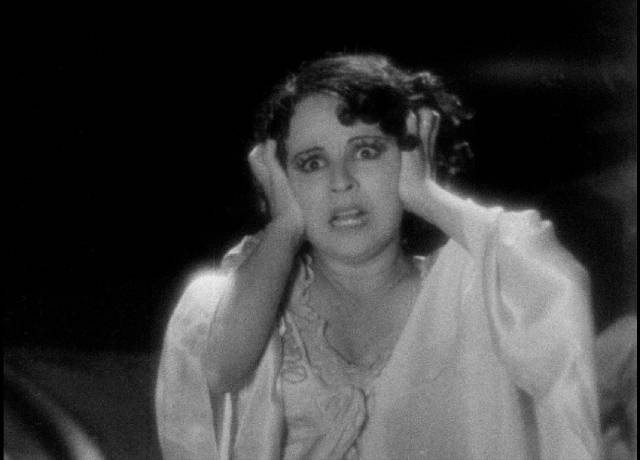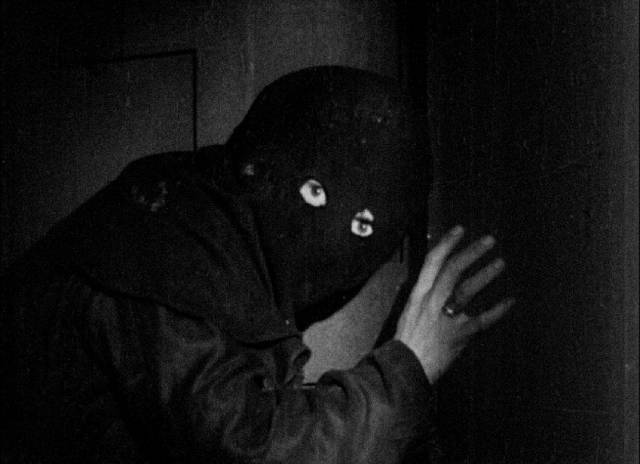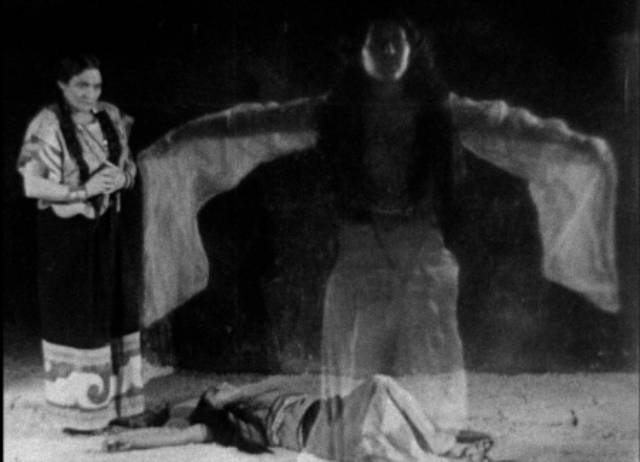Early Mexican horror from Indicator

One of the highlights of Criterion’s series of World Cinema Project sets was Juan Bustillo Oro’s Dos monjes (1934). That feverish work of Expressionistic horror was part of the initial attempt by Mexican filmmakers to forge a national cinema in the early sound era. One impetus for this movement was the Hollywood practice of simultaneously making Spanish-language versions of studio productions to take advantage of a large ready-made audience in the radically altered marketplace which had undermined the universality of silent cinema. While many of these productions were financially successful, there were drawbacks, particularly an insensitivity to linguistic specificity and dialect variations among different regions.

In building an indigenous industry, Mexico drew on the talent and technical ability of people who had learned their craft in Hollywood and Europe; but while productions reflected certain creative tendencies which had evolved elsewhere, filmmakers sought subjects rooted in the national culture. Given the success of Universal’s Spanish-language Dracula (1931), it isn’t too surprising that some of the earliest local productions aimed to exploit a taste for horror, while finding material in local folklore and legend. Styles might be imported, but stories were found at home.
Adding to the revelatory quality of the restored Dos monjes, Indicator have just released two more horror movies from the same period. It’s an indication of how small the nascent industry was that Bustillo Oro, who co-wrote and directed Dos monjes, also co-wrote El fantasma del convento (1934) with director Fernando De Fuentes, who in turn co-wrote La llorona (1933), the first Mexican horror film, and one which drew very specifically on a well-known Mexican folk legend.

La llorona (Ramón Peón, 1933)
Ramón Peón’s La llorona (“the crying woman”), the legend and the movie, is steeped in gender, class and race issues rooted in Mexico’s colonial past. Although the story exists in a number of iterations, they all touch on the betrayal of a woman by a man who is the father of her child (or children), who eventually kills herself and the child and then wanders at night in search of the child she killed, her cries terrifying anyone who hears her.

The movie begins with a man pausing at night by a cemetery gate to light a cigarette; when he hears the unearthly howls of la llorona, he has a heart attack and drops dead. The next day, as a doctor rules it a natural death, he gets into an argument about a possible supernatural cause. This doctor is Ricardo De Acuna (Ramon Pareda), a rationalist, who dismisses the idea of ghosts. Back home, his eight-year-old is celebrating his birthday with a group of children while a servant hovers nearby, concerned about a family legend in which the first-born is destined to die when he turns eight.

This leads to an extended flashback to colonial times and the story of the doctor’s ancestor (Pareda again) who had a child with his mistress, whom he had promised to marry, although he continually puts it off, keeping their relationship secret because she’s not of his own class. When he marries the daughter of another wealthy family instead, she kills her son and herself. Not satisfied with this narrative, the script goes even further back for another account of la llorona’s origins in the time of the conquistadors, with another ancestor (Pareda yet again) having a child with an Aztec woman, who again is betrayed, and who curses his line before killing herself and her child.

Back in the present, a sinister masked figure prowls the doctor’s house, eventually revealed to be one of the family servants, a descendant of the Aztec woman, who is set to sacrifice the doctor’s son at an altar deep under the house. This is where the film tries to pull its disparate elements together, not entirely successfully – although the curse is being carried out by a very human character, the spirit of la llorona puts in an appearance, trying to have it both ways; the two historical flashbacks offer alternate explanations, one supernatural, one rational and the climax attempts to combine them both, but instead just confuses things. What does remain consistent is the idea of racial/cultural/gender trauma rooted in Mexico’s colonial past which lingers into the present with the threat of continual violence. La llorona is a manifestation of the on-going consequences of privileged European male arrogance which has used and abused indigenous women.

Despite the disjointed narrative, La llorona was a prestige production, with some large-scale sets embodying three different historical periods, atmospherically shot by cinematographer Guillermo Baqueriza. It was seen at the time as a significant movie, not only as an indication that the Mexican industry was capable of producing films which could compete with imports from the States and Europe, but also because it embodied a specifically Mexican subject. And yet, the film had virtually vanished for half a century until this new restoration.

The restoration itself is an impressive feat. The only known surviving element is a well-worn 16mm print, rife with damage – scratches, torn sprockets, missing frames and ragged splices – and yet the restorers have managed to extract an image with a surprising amount of detail and decent contrast. A lot of the damage has been cleaned up but without losing the authentic texture of the 16mm grain. While they did remove the larger-than-usual reel-change marks (strangely designed as crescent moons and stars rather than the typical “cigarette burn” circle), these have been preserved as one of the disk extras.
The commentary by Kim Newman and Stephen Jones is chatty, but occasionally seems a bit unprepared, with them correcting each other on details. More focused and informative is an interview with Mexican festival programmer Abraham Castillo Flores (17:01) whose enthusiasm for the film and its miraculous resurrection is contagious. More personal is a short documentary about the production by Viviana García Besné , the great granddaughter of the producer, who is seen as a young child in the birthday party sequence at the start of the film, transforming La llorona for a moment into a strange, touching home movie.
*

in Fernando de Fuentes’ The Phantom of the Monastery (1934)
The Phantom of the Monastery
(Fernando de Fuentes, 1934)
Made the following year, Fernando de Fuentes’ The Phantom of the Monastery (El fantasma del convento) is a morality tale, almost a religious allegory, in the form of a horror film. It’s rooted not in folklore but rather Catholicism. Night has fallen on three people out for a hike in the mountains. One of them, Eduardo (Carlos Villatoro), has slipped and is clinging to a tree jutting from a cliff above a ravine. The other two, his wife Cristina (Marta Roel) and their friend Alfonso (Enrique del Campo), manage to pull him to safety, but it’s cold and dark and it appears they’ll be stuck in the woods for the night.

A figure emerges from the darkness, a tall man dressed in black with a big dog at his side. He tells them there’s a monastery nearby – one of the friends comments that he’s heard of an abandoned ruin in the area – and he leads them to it. As they knock at the door, the man disappears. A monk invites them in and tells them they can stay the night, but they must respect the brothers’ vow of silence. As they are led to cells where they can sleep, monks drift past them in the corridors, not even acknowledging their presence.

Once left alone, Cristina slips into Alfonso’s cell; he warns her that they must be careful as her husband is nearby and might hear them. She responds that they should have let him fall from the cliff. Whether Eduardo understands that his wife and friend are betraying him is unclear, but the emotional triangle they form shapes the strange experiences they will have during the night. Those experiences include creepy encounters with mostly silent monks, the discovery of a cellar lined with mummified monks, all culminating in a spartan meal in the refectory during which the Prior (Paco Martinez) relates a story about a man, his wife and her lover which ends in the murder of the husband.


Back in their cells, they experience hallucinatory visions of guilt and damnation, manifestations of consciences prodded by the Prior’s obvious knowledge of their secrets. When dawn arrives, they discover that the monastery is derelict and empty, obviously long uninhabited and falling into decay. But there are clues that their shared experiences were real and they leave with an awareness of the risks of giving in to their illicit desires, having been given a warning of the consequences of making the wrong decision.

Something like a Twilight Zone story in which Rod Serling’s liberal ironies have been replaced with a dose of conservative moral censure, The Phantom of the Monastery is moody and atmospheric, benefiting from the use of an actual old monastery in Tepotzotlan (which by an odd coincidence I visited in the summer of 1983) which adds an air of authenticity to the story (the mummified monks we see were genuine). The cast is good, with Marta Roel embodying with an erotic charge the temptation which threatens both men.

With a restoration sourced from the original 35mm nitrate negative, the image here is much stronger than that of La llorona, with deep blacks and strong contrast and a great deal of fine detail. I haven’t listened to the commentary by Newman and Jones, but once again programmer Abraham Castillo Flores provides an enthusiastic introduction (18:01) to the production and the impact of the film on Mexican cinema.
Together with Dos monjes, these two movies introduce a little known area of horror cinema which was not really pursued by the Mexican industry although it seems clear that the seeds of the horror revival of the 1950s and ’60s were planted here; the work of Chano Urueta, Fernando Mendez, Rafael Baladon and others was rooted in this tradition rather than the newer influences of Terence Fisher at Hammer Films, Roger Corman at American International or Mario Bava and others in Italy. Mexican horror has been very much an indigenous genre and its origins were in these movies of the early ’30s.
Comments